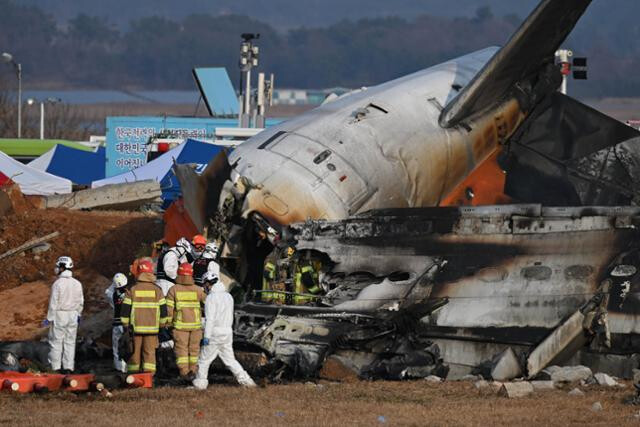
Seoul, South Korea - In a decisive move to bolster aviation safety, the South Korean Ministry of Land, Infrastructure and Transport (MOLIT) unveiled a comprehensive "Aviation Safety Innovation Plan" on April 30th. The new measures aim to penalize airlines responsible for fatal accidents, enhance aircraft maintenance protocols, and improve safety infrastructure at airports across the nation. While the announcement signals a strong commitment to preventing future incidents, it notably did not include the establishment of a dedicated aviation safety agency, a point that may draw future scrutiny.
A key component of the announced plan involves imposing significant repercussions on airlines involved in accidents resulting in fatalities. Starting as early as the latter half of this year, any South Korean airline that experiences an accident causing even a single death will be barred from participating in the competition for new international route allocations for a period of one year. To implement this stringent measure, MOLIT will revise the "Regulations on the Allocation of Traffic Rights" by September. This policy shift underscores the government's intent to hold airlines directly accountable for safety lapses with the most severe consequences.
Furthermore, MOLIT will introduce a new "Aviation Safety Performance Index." This index will quantify an airline's safety record by tracking incidents such as flight diversions, in-flight fires, and engine shutdowns. Airlines demonstrating a poor safety performance based on this index will face intensified inspections and potential restrictions on the approval of new routes. This proactive approach aims to identify and address potential safety risks before they escalate into major incidents.
Recognizing the critical role of aircraft maintenance in ensuring flight safety, the innovation plan mandates a significant increase in pre- and post-flight maintenance times. These adjustments, varying between 7% and 28% depending on the aircraft model, will provide maintenance crews with more time to conduct thorough checks and address any potential issues. Additionally, the minimum experience requirement for designated maintenance personnel, previously set at two years considered "highly experienced," will be raised to three years. This extension aims to ensure a higher level of expertise and proficiency among those responsible for aircraft upkeep.
The financial stability of airlines as a factor influencing their capacity for safety investments is also being addressed. MOLIT plans to increase the minimum paid-up capital required for obtaining an airline operating license. The current thresholds, 15 billion KRW (approximately $11 million USD) for international operations and 5 billion KRW (approximately $3.7 million USD) for domestic operations, are deemed insufficient to guarantee robust safety investments. The specific new capital requirements are expected to be announced following further review.
Beyond airline-specific regulations, the "Aviation Safety Innovation Plan" includes measures to enhance safety at South Korean airports. Notably, six regional airports – Muan, Gwangju, Yeosu, Pohang Gyeongju, Gimhae, and Sacheon – will undergo significant upgrades to their localizer (LOC) systems, a critical component of the Instrument Landing System (ILS) that provides lateral guidance to aircraft during landing. Existing earthen mounds associated with these systems will be replaced with level ground, and concrete foundations will be substituted with frangible lightweight steel structures. These changes are designed to minimize potential damage to aircraft in the event of an overrun or deviation from the runway. Moreover, all airports nationwide will be required to secure a Runway End Safety Area (RESA) of at least 240 meters, providing additional stopping distance for aircraft during landing or takeoff.
Addressing the persistent threat of bird strikes, which can cause significant damage to aircraft engines and airframes, MOLIT announced the phased introduction of bird detection radar systems. Muan International Airport will serve as the pilot location for this technology in the latter half of this year, with subsequent deployments planned for major hubs including Incheon, Gimpo, and Jeju International Airports by the following year. Complementing this initiative, bird deterrent drones will be deployed to joint civilian-military airports in the first half of 2025. Looking further ahead, MOLIT aims to develop and deploy artificial intelligence (AI)-equipped bird control drones at all airports across the country by 2028. To further strengthen bird strike prevention efforts, the minimum dedicated personnel at airports will be doubled from the current two individuals to four.
While the "Aviation Safety Innovation Plan" outlines a series of significant improvements to aviation safety in South Korea, the absence of a proposal to establish a dedicated aviation safety agency has drawn attention. Currently, aviation safety oversight falls under the purview of MOLIT's aviation policy bureau. Critics have long argued that creating an independent agency, similar to those in other leading aviation nations, would provide a more focused and autonomous approach to safety regulation and enforcement, potentially leading to even greater improvements in air safety. The omission of this measure in the current plan may lead to continued debate and advocacy for a more independent regulatory body in the future.
The implementation of these new regulations and infrastructure upgrades will be closely monitored by both the aviation industry and the public. Airlines will need to adapt to stricter maintenance schedules, increased financial requirements, and the potential consequences of safety incidents. Airports will undertake significant infrastructure projects to enhance safety zones and implement new technologies for bird strike prevention. The success of the "Aviation Safety Innovation Plan" will ultimately be judged by its ability to reduce the occurrence of accidents and further enhance the safety of air travel in South Korea. This comprehensive set of measures represents a significant step towards achieving that goal, demonstrating the government's commitment to prioritizing the safety and well-being of passengers and the broader public. The focus now shifts to the effective implementation and enforcement of these new regulations to ensure a safer and more reliable aviation environment in South Korea.
[Copyright (c) Global Economic Times. All Rights Reserved.]






























